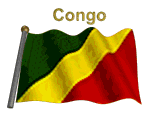
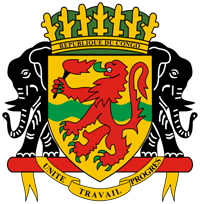



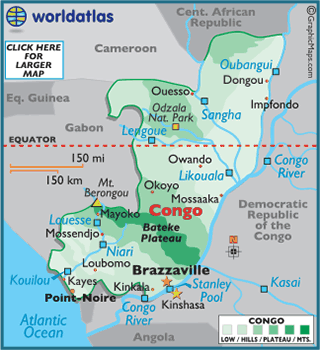
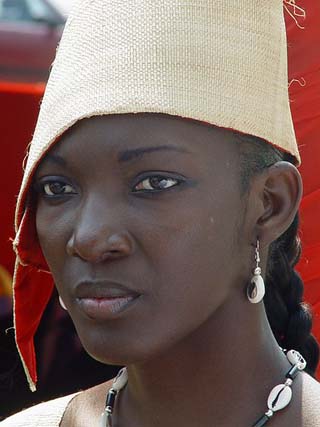

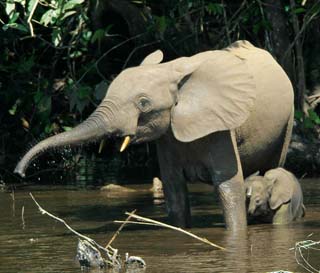
Tel Code..: +242
Ethopian Airlines - Air France
Viza..: Needs
Courses or boosters usually advised: Hepatitis A; Poliomyelitis; Tetanus; Typhoid; Yellow Fever.
Other vaccines to consider: Cholera; Diphtheria; Hepatitis B; Meningococcal Meningitis; Rabies.
Yellow fever vaccination certificate required for travellers over 1 year of age arriving from countries with risk of yellow fever transmission.
Name: Congo Republic Of
President:Denis Sassou-Nguesso (1997)
Prime Minister:Isidore Mvouba (2005)
Land area:131,853 sq mi (341,499 sq km);total area:132,047 sq mi (342,000 sq km)
Population (2012 est.):4,366,266 (growth rate: 2.85%); birth rate: 40.09/1000; infant mortality rate: 74.22/1000; life expectancy: 55.27; density per sq km: 11
Capital and largest city (2009 est.):Brazzaville, 1,292,000
Other large city:Pointe-Noire, 544,200
Monetary unit:CFA Franc
Description (Page 1)
The Republic of the Congo was first settled by the illusive Pygmies that were
slowly replaced by the Bakongo, Bateke and Sanga peoples in the mid-15th century.
 Once the Portuguesediscovered
the coastal areas, the natives (having made friends quickly) began to cooperate
with theEuropeans,
and the slave trade started to flourish. The coastal area, in fact, became a
major source for the transatlantic trade.
Once the Portuguesediscovered
the coastal areas, the natives (having made friends quickly) began to cooperate
with theEuropeans,
and the slave trade started to flourish. The coastal area, in fact, became a
major source for the transatlantic trade.
A series of revolts led by Kimpa Vita during the 17th century ultimately soured
the relationship between the Kongolese and Portuguese. These battles lasted
throughout much of the 1600s, as the Kongolese fought the Portuguese against
their push for extra territorial rights.
Kimpa Vita, a Catholic nun, established the Anthonian prophetic movement after
seeing visions of St. Anthony of Padua commanding her to restore the kingdom of
Kongo. Although her revolt was short lived, and relatively unsuccessful, she
managed to capture the capital Mbanza Kongo. Portuguese Capushin
Friars condemned Kimpa Vita for being a witch, and ordered her death.
For many nationalists she is a symbol of Africanresistance
against early colonialism, and widely regarded as the African version
of Joan of Arc.
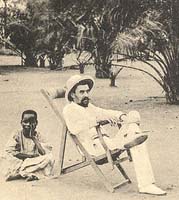 Over many decades,
an array of Europeantraders
searched for additional economic opportunities within the Congo region, and then,
in 1891, this resource-rich land was colonized by theFrench,
and named the French Congo
- later the Middle Congo.
Over many decades,
an array of Europeantraders
searched for additional economic opportunities within the Congo region, and then,
in 1891, this resource-rich land was colonized by theFrench,
and named the French Congo
- later the Middle Congo.
Under the command of the French,
the natives of the Congo suffered through forced labor, and saw their valuable
rubber and ivory resources exploited as well.
In 1945, Jean-Felix Tchicaya was elected into the FrenchParliament,
becoming one of the first African leaders
given the opportunity.

Coastline: 105 miles (169 km)
From
the grasslands of the narrow coastal plain, the land rise into the rounded, low
hills of the Bateka Plateau, and the elevated, mountainous regions along its
western border with Gabon.
Mount Berongou, the Congo's highest point, is located in the upper reaches of
the Crystal Mountains on the border with Gabon.
It rises to about 903 meters (2,963 feet).
Further inland and to the northeast, the land flattens, all covered by a dense
equatorial rainforest.
The Congo River is the longest river in the Congo, the second-longest river in Africa,
and the sixth-longest river in the world, with a total length of about 4,700 km
(2,920 mi).
The Stanley Pool is a lake formed by the widening of the Congo River. It lies
between the borders of the Congo and the Democratic
Republic of the Congo.
It covers an area that is about 35 kilometers (22 miles) long and 23 kilometers
(14 miles) wide.
The capital cities of both the Congo and the Democratic
Republic of the Congo are
located on the shores of Stanley Pool, and river ferries serve the area.
The lowest point of the country is the Atlantic
Oceancoastline
(0 m).
Climate:
With its position on the Equator, the Congo is hot and humid throughout the year,
with daily high temperatures near 90°F (32°C).
In addition, the equator region receives significant rainfall throughout the
year.
In the south there is a rainy season from October to December, a short dry
season in January, another rainy season from March to June, and a long dry
season from June to October.
In the north, the seasons are reversed. Annual rainfall varies from 41 inches
(105 centimeters) at Pointe-Noire in the southwest, to 73 inches (185
centimeters) at Impfondo in the northeast.
Petroleum production (which supplies a major share of government revenues and exports), forestry, and agriculture are the chief economic activities in Congo. Domestic food production does not meet national demand, and food must be imported in large quantities. The major subsistence crops are cassava, rice, corn, and vegetables. Sugarcane, cocoa, and coffee, raised primarily on plantations, are important export crops, as are peanuts, palm products, and tobacco. Lumber and plywood are also important exports, as are diamonds. Diseases restrict cattle raising, and fishing is not well developed.
Industry is limited mainly to the processing of petroleum and agricultural and forest products; much of it is concentrated in Brazzaville and Pointe-Noire and in the Niari valley. Although attempts have been made to diversify the economy, it is still largely dependent on petroleum and influenced by fluctuating world oil prices. Mining is important, with oil, diamonds, and potash the principal mineral exports. Lead, zinc, uranium, copper, phosphates, and natural gas are other important mineral resources. China, the United States, and France are the major trading partners.
Congo is governed under the constitution of 2002. The president, who is both head of state and head of government, is popularly elected for a seven-year term and is eligible for a second term. The bicameral legislature consists of the 66-seat Senate and the 137-seat National Assembly. All legislators are popularly elected to five-year terms. Administratively, the country is divided into ten regions and the Brazzaville federal district.
The terrain is covered mainly by dense tropical rain forest, with stretches of wooded savanna. Tributaries of the Congo and Ubangi rivers, which separate Congo from the Democratic Republic of the Congo, flow through the country. The climate is warm and humid and rainfall is heavy. The Congo serves as the transport and commercial hub of central Africa, with economically important road, river, and rail systems connecting inland areas with the Atlantic. The country's internal road network is inadequate, however, and has hampered economic development.
About half of the nation's population resides in urban areas, and the population density is relatively low. There are about 15 ethnic groups in Congo, and these are subdivided into some 75 smaller groups. The Bakongo, who make up nearly half of the population, are mostly farmers or traders and live primarily around Brazzaville; they are Bantu-speaking, as are the Bateke (who live north of Brazzaville), the Sanga, and the Mbochi. Pygmies live in the north, and Vili people dwell along the coast. About half of the Congolese people practice traditional religions; the rest are primarily Christian, although there is a small Muslim minority. French is the country's official language, but many African languages, including Lingala and Monokutuba (both lingua franca trade languages) and Kikongo, are widely spoken.